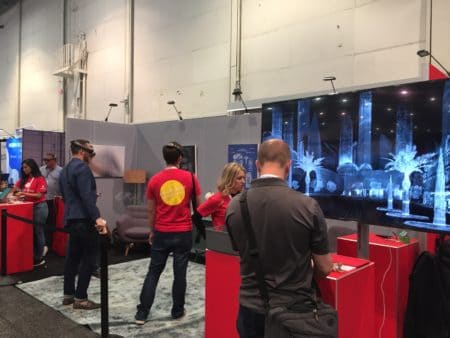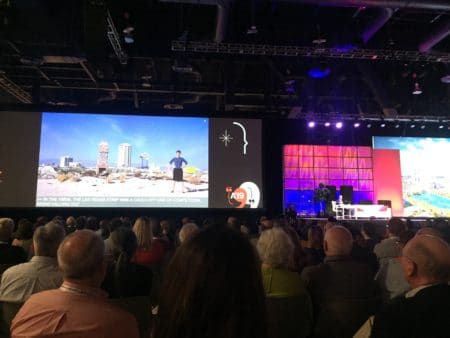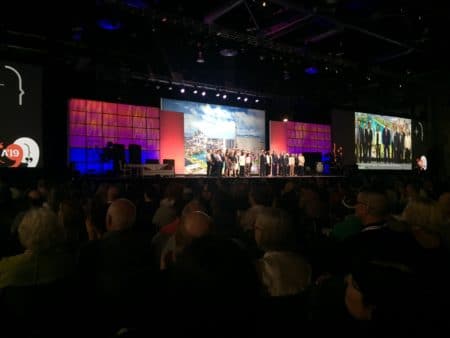Architecture, BIM and the future of the entire AEC industry were all on tap in Las Vegas last month, where the GRAPHISOFT Key Client Conference (KCC) and the AIA National Convention all converged on each other in the span of one week. Between the two events, we came in contact with several dozen innovative technology companies—several of them very new to the market or others we never knew about.
In the next few AIA prefaced articles on Architosh, we will be talking about these companies and their solutions for the architecture or AEC market. These articles will roll through everyone who was at AIA as well as mention folks at the GRAPHISOFT KCC.
Who Was There—Why It Matters
At the AIA National, we can always count on the big four AEC software firms being in attendance—except this year! While Autodesk, Bentley and the Nemetschek companies were there, gone from the exhibitor floor this year was Trimble and thus the usually popular SketchUp booth.

Magic Leap was on display in its first attendance at AIA 19 in Las Vegas. the company’s Magic Leap One MR headset was deeply impressive and noted as a BEST of SHOW winner this year.
While that news isn’t good in their place were gaming giants Unity and Epic with its Unreal Engine. Unity, in particular, had a major booth showcasing its Unity Reflect for Revit—an innovation category BEST of SHOW award winner this year.
Also at this year’s show was Magic Leap with its new-to-market Magic Leap One MR headset. IrisVR and InsiteVR were also at the show, in addition to the three big popular interactive renderers in Twinmotion, Lumion, and LumenRT (Bentley). Headsets were everywhere! Including at the Enscape booth.
So why does this matter?
It matters because this year, the “game-ification” of architectural technologies theme we have discussed since 2014 hit full force. Over at the GRAPHISOFT Key Client Conference (KCC), which took place immediately before the AIA convention, we witnessed the convergence of game technologies and democratizing web technologies all in one go with the upcoming BIMx for the web browser. Game technologies are everywhere in AEC now and it’s going to continue in a big way and it’s going to transform the AEC industry.
Democratization and Inclusion—Why It Matters
We will continue with a full listing of technologies companies at AIA 19 and discuss what they were showing in our show floor reports coming up. In this article, we want to capture some of the bigger impressions from Vegas—like “game-ification” of technologies.
During the first keynote, things started with a retrospective of Robert Venturi and Denis Scott Brown’s influential book, Learning from Las Vegas. Completely appropriate given the AIA convention’s location, it was made even more so within the current cultural climate of #metoo and other themes of inclusion and access. It was during this segment that I learned that it was Denis Scott Brown who was first interested in Las Vegas as an architectural laboratory for new ideas. Robert Venturi caught the bug, sort-of-speak, for Vegas a bit later. The initial spark of theoretical innovation was Denis’s outright.

Architect Denis Scott Brown is shown in this image in front of the city of Las Vegas. It was she who first found interest in the desert city as a laboratory for architectural innovation and theory.
In the preface to the revised edition of the book (of which I have a hard copy), she writes:
Robert Venturi’s note on the attribution in the first edition, with its request for fairness to his co-authors and co-workers, was virtually ignored by almost all reviewers. Personal pique at the cavalier handling of my contribution and at attributions in general by architects and journalists led me to analyze the social structure of the profession, its domination by upper-class males, and the emphasis its members place upon the architectural star system.
To learn that the spark or seed that everything that Learning from Las Vegas would later become came from Denis made the words in the quote above even more accurate and depressing in the context of Denis being skipped over by the Pritzer Prize jury for awarding (in 1991) the highest honor within Architecture to Robert Venturi alone. (see: Dezeen, “Robert Venturi joins call for Pritzker to recognize Dennis Scott Brown,” 4 April 2013).
You may ask, why does democratization of technologies matter so much in the context of the field? The answer to us is because “systems of exclusion”—as modes of operation that systemically narrow choice, mask availability of choice, or make false dichotomies about choice—all follow the same patterns and results and lead to unjust circumstances. And such circumstances lead to lower performance of individuals, teams, firms, organizations, and even industries and countries.
To hear Karen Braitmayer, FAIA, on stage in a wheelchair say that those with disabilities are more spatially aware not only made logical sense but even more poignantly when she pleaded why are people with disabilities not more employed in a field that deals with space?
And to hear from Reshma Saujani, founder and CEO of Girls Who Code, tell the audience that girls are socially programmed to strive for perfection and not take risks like boys and that “they needed to be brave not perfect” made even more sense when she revealed that she, herself, doesn’t know how to code.

Payette of Boston was the AIA Firm of the Year in 2019. On stage at AIA 19 in Vegas, the firm noted its culture of diversity and inclusion as keys to its success. Whether you are an old employee or hired last week, everyone is encouraged to share their opinions and ideas, is the firm’s belief system.
The industry and field of Architecture have some serious cultural issues that must be overcome, lest it falls terribly behind larger societal themes well underway. Inclusion was a mapped theme at the AIA 19 in Vegas and it will largely remain so until the issues are resolved. The field needs inclusion in order to succeed. It needs to tap the talents and passions from all who want to join it in order for it to survive the transform in the Age of AI. Technologies presented at AIA 19 this year that showed a clear commitment to democratized access and liberalized data formats were more duly acknowledged because of these overarching themes.
Coming up next, reports from the show floor.



Reader Comments
For 35 years I have worked in an industry that didn’t really want me around. So to hear the beginnings of inclusion in architecture is great. But I can’t hear anyone else…(chirp) Where is everyone?
So many minds wasted. So many ideas lost. So much possible innovation from the past 30 years ignored. Just because I look different…Because of my gender…because I speak a different language?
For this, the industry is dying. Yet it will be saved by including everyone who aspires to be an architect…
For 35 years I have worked in an industry that didn’t really want me around. So to hear the beginnings of inclusion in architecture is great. But I can’t hear anyone else…(chirp) Where is everyone?
So many minds wasted. So many ideas lost. So much possible innovation from the past 30 years ignored. Just because I look different…Because of my gender…because I speak a different language?
For this, the industry is dying. Yet it will be saved by including everyone who aspires to be an architect…
You are correct. The medical industry is amazing when it comes to inclusion and technology. I’ve. completed over 10 years of Hospitals, Clinics, and MOB’s. I have always felt valued and successful.
I ran an outreach program at UC Berkeley in 2014. Unfortunately, it failed. But currently, there are some programs in Atlanta, Philadelphia, and Chicago for high school seniors. But Oakland, Ca. may be the most promising. (However, at this time, no female participation)
Bob, thanks for writing in and sharing your thoughts. I agree with you that the industry—specifically the Architecture industry—has been horrible at inclusion and has hurt itself more than it realizes. Some industries, especially STEM industries and medicine, have done tremendously better at inclusion. Innovation and creativity can often be measured in more quantitative terms, or just as critically, measured in terms more relevant to our current digital age, and this obviously helps the situation you speak of.
Bob, thanks for writing in and sharing your thoughts. I agree with you that the industry—specifically the Architecture industry—has been horrible at inclusion and has hurt itself more than it realizes. Some industries, especially STEM industries and medicine, have done tremendously better at inclusion. Innovation and creativity can often be measured in more quantitative terms, or just as critically, measured in terms more relevant to our current digital age, and this obviously helps the situation you speak of.
You are correct. The medical industry is amazing when it comes to inclusion and technology. I’ve. completed over 10 years of Hospitals, Clinics, and MOB’s. I have always felt valued and successful.
I ran an outreach program at UC Berkeley in 2014. Unfortunately, it failed. But currently, there are some programs in Atlanta, Philadelphia, and Chicago for high school seniors. But Oakland, Ca. may be the most promising. (However, at this time, no female participation)
Comments are closed.